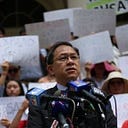How Did the AAPI Community Do In the 2021 NYC Primaries?
The counting of absentee ballots is complete and most of the Democrat primary winners will go on to be elected in November. The League of Asian Americans of New York counted a historic 50 AAPI candidates running in this primary, how did the AAPI community do?
Obviously the AAPI icon Andrew Yang lost but managed to muster about 100,000 first place votes, not enough to win but clearly activated a record voter base. Eric Adams as mayor is not a loss for the Asian community. One of his first stops after ranked choice votes were tabulated, was the Flushing community where he thanked his supporters at a dinner. Compare that to De Blasio who’s first engagement with Asians 8 years ago was to call them out for overpopulating the Specialized High Schools.
In the city council races there will be a historic number of AAPI and women representatives. Where it had only been Peter Koo and Margaret Chin from the AAPI community, we will now probably have six, including; Sandra Ung-Flushing, Linda Lee-Fresh Meadows, Julie Won-Sunnyside, Shekar Krishnan-Jackson Heights, Felicia Singh-Ozone Park, and Shahana Hanif-Park Slope. These candidates come with their own political platforms but at least they were able to break the barrier in terms of race and ethnicity for AAPIs.
If admission to the specialized high schools and support for keeping the SHSAT is a reflection for a candidates support for the Asian American community, then the community also did well. Eight years ago, only 2 city council members stood up for the SHSAT, Peter Koo and Ben Kallos. Through LAANY’s candidate forums and interviews, the organization believes there at least seven proponents that will be elected in the city council in addition to Adams.
6 out of 50 AAPI candidates may sound like a low yield rate but seen another way, it is a 300% increase for AAPI representation since the last council race. By the way, for those who lost, we’ll probably be seeing them again soon.
